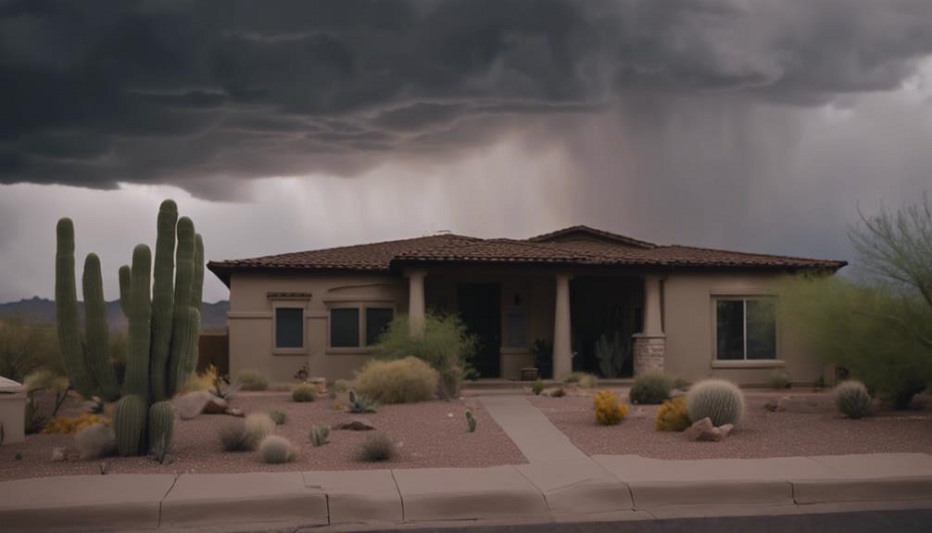
If your roof’s been rattled in Phoenix, you might have hail damage. Look for dents, dimples, or missing granules on your shingles, which create dark, exposed areas. You’ll also find dents on metal flashing, vents, and even air conditioning units outside. Don’t ignore these signs; they can lead to leaks, mold, and expensive repairs down the line. Safety first: use a stable ladder and wear non-slip shoes when inspecting. Documenting what you find and taking swift action can prevent further damage. There’s more to learn about protecting your home and managing the next steps.
Key Takeaways
– Check for dents and dimples on your roof, indicating hail impact.
– Inspect shingles for missing granules, cracks, or signs of bruising.
– Look for damage on metal components like flashing, vents, and gutters.
– Assess roof accessories for dents, rust, and any airflow obstruction.
– Document all signs of damage and contact your insurance company for next steps.
Recognizing Hail Damage
Typically, hail damage on your property manifests as dents and dimples on roofs, siding, and vehicles. If you’re in Phoenix, a city not unfamiliar with such weather events, it’s essential to recognize these signs early. After a storm, you might notice more than just the obvious dents. Look closer, and you’ll see chipped paint or splintered wood on your siding. These are telltale signs that hail has compromised the integrity of your property’s exterior.
Your windows and screens might also bear the brunt of hail. Cracks, holes, or shattered glass are clear indicators of hail impact. Don’t overlook your outdoor air conditioning units either. The metal casings can show dents and punctures, hinting at the storm’s severity.
It’s easy to miss these signs if you’re not looking closely, but they’re vital for understanding the extent of the damage. Remember, hail doesn’t discriminate; it can affect every outdoor surface. By recognizing these signs early, you’re taking the first step toward mitigating further damage and preparing for repairs. Keep your eyes peeled and take action promptly to protect your property from the aftermath of a hailstorm.
Common Signs on Shingles
When examining your roof for hail damage, it’s essential to spot the common signs on shingles, such as missing granules and cracks. Hail can wreak havoc on your roof, and early detection is key to avoiding more serious problems down the line. Here’s what you need to look out for:
1. **Missing Granules**: Check for patches where the shingle’s granules have been knocked off. These spots often look like dark, exposed areas where the underlying asphalt is visible.
2. **Cracks**: Hailstones can cause cracks in the shingles. Look for signs of splitting, which can lead to leaks if left unattended.
3. **Bruising**: Sometimes, the damage isn’t as obvious. Gently run your hand over the shingles to feel for any small dents or bruises. These softer spots are subtle indicators of hail impact.
4. **Lifting Shingles**: Strong hail can lift or dislodge shingles, compromising your roof’s integrity and making it susceptible to water damage.
If you spot any of these signs, it’s important to take action. Ignoring hail damage can lead to leaks, mold, and costly repairs in the future.
Inspecting Metal Components
After examining the shingles, it’s important to inspect the metal components of your roof for hail damage signs. Hail can dent or even puncture metal roofing materials, leading to leaks and other issues down the line. Here’s how you can spot the damage:
Start by looking at the metal flashing and vents on your roof. These areas are particularly vulnerable to hail. If you’re not sure what to look for, use this table as a guide:
| Component | Damage Sign | Potential Impact |
|——————|————————–|——————————-|
| Metal Flashing | Dents or punctures | Increased risk of water leakage |
| Vents | Bent or misshapen edges | Compromised ventilation |
| Gutters and Downspouts | Dings or discontinuity | Poor water drainage |
Look for any irregularities in the surface. Even small dents or changes in the texture can indicate hail damage. Remember, it’s not just about aesthetics; these damages can compromise the integrity of your roof’s structure and lead to significant issues if not addressed promptly. If you spot any signs of damage, it’s essential to contact a professional for a thorough inspection and repair to assure your roof’s longevity and functionality.
Checking Roof Accessories
After examining the metal components of your roof, it’s vital to check the accessories as well.
You’ll want to scrutinize vent covers, assess chimney seals, and make sure gutters and downspouts are damage-free.
These areas can be especially susceptible to hail, so giving them a thorough look will help you evaluate the overall impact.
Inspect Vent Covers
Examining vent covers is an essential step in identifying hail damage on your Phoenix home’s roof. These components can reveal a lot about the recent weather impacts your roof has endured. Here’s how to do it effectively:
1. **Look for Dents and Dings**: Hail often leaves distinctive marks that are easy to spot.
2. **Check for Rust or Corrosion**: Damage can accelerate the wear process, leading to these issues.
3. **Inspect for Loose or Missing Parts**: Hail impact might dislodge or damage vent components.
4. **Ensure Vents are Still Functional**: Damage could obstruct airflow, compromising your roof’s ventilation.
Examine Chimney Seals
Inspecting your chimney seals is another crucial step in assessing hail damage on your Phoenix home’s roof. Hail can compromise the integrity of these seals, leading to leaks and water damage inside your home.
Start by looking for any cracks or splits in the sealant around the base of your chimney. These are clear indicators that the seal has been compromised. Additionally, check for missing pieces or areas where the sealant may have been completely knocked away by hail impact.
It’s not just about water; a damaged chimney seal can also increase your home’s vulnerability to pests. If you’re not sure what to look for, consider hiring a professional to inspect your chimney seals. They’ll know exactly how to spot trouble and recommend the best course of action.
Gutters and Downspouts Check
Next, redirect your attention to the gutters and downspouts, as they’re crucial for guiding water away from your home’s foundation. Hail can dent or even puncture these essential components, leading to potential water damage. Here’s what you need to inspect:
1. **Dents and Damage:** Look for any visible dents or damage on gutters and downspouts. Hail impacts can compromise their integrity.
2. **Blockages:** Confirm there are no blockages caused by hailstones. Clogged gutters can lead to water overflow.
3. **Leaks:** Examine for any leaks that may have formed as a result of hail damage. Even small leaks can lead to significant problems over time.
4. **Attachments:** Verify that all gutters and downspouts are securely attached to your home. Hail can sometimes knock these loose.
Assessing Ventilation Systems
When evaluating ventilation systems for hail damage, it’s important to start by inspecting the external vents for any visible signs of impact. Hail can leave distinct marks or even create punctures in softer materials, so you’ll want to look closely for any irregularities. Don’t just focus on the most exposed parts; check the sides and edges where damage might be less obvious but equally vital.
Next, assess the functionality of these vents. Hail impacts can sometimes dislodge or block ventilation pathways, leading to reduced airflow. If you’ve got attic ventilation, make sure to access this area safely to inspect for any internal signs of damage. Look for dislodged screens or guards that could indicate hail has made its way into the system.
It’s also wise to test the airflow of each vent. If you notice a significant decrease in air movement, there may be a blockage or damage within the system that’s not immediately visible from the outside. This step is crucial for maintaining good air quality and temperature regulation in your home.
Spotting Less Obvious Indicators
Beyond the clear signs, you’ll need to look out for subtler indicators of hail damage.
Pay attention to granule loss and hidden shingle damage, which mightn’t catch your eye initially.
These lesser-known signs can clue you in on the extent of the damage your roof might’ve endured.
Granule Loss Signs
Identifying granule loss on your roof may not always be straightforward, as subtle signs often escape the untrained eye. However, recognizing these can be vital in evaluating hail damage. Here’s what to keep an eye out for:
1. **Bare Spots:** Areas where shingles are visibly stripped of granules.
2. **Gutters Filled:** Check your gutters for an accumulation of granules, a tell-tale sign of recent loss.
3. **Inconsistent Color:** Look for patches where the roof color appears lighter or patchy, indicating granule wear.
4. **Shiny Asphalt:** Exposed asphalt shingles without granules can appear unusually shiny.
Spotting these indicators early can save you from more extensive damage down the line. Don’t overlook these less obvious signs of wear and tear on your roof.
Hidden Shingle Damage
While you’re on the lookout for granule loss, don’t forget to check for less obvious signs of shingle damage that might go unnoticed. Cracks or splits in shingles, often subtle, can compromise your roof’s integrity.
Look for any bending or curling at the edges of the shingles; these deformities suggest they’re not effectively protecting your home anymore. Also, keep an eye out for loose or missing nails that can indicate underlying shingle damage.
Even small punctures, sometimes caused by hail or debris, can lead to significant water ingress over time. It’s these hidden damages that, if ignored, can escalate into costly repairs.
Regularly inspecting your roof, especially after severe weather, is key to catching these sneaky culprits early.
Safety Tips for Roof Inspection
Before climbing onto your roof to check for hail damage, make sure you’re equipped with the proper safety gear to prevent accidents. Have Prowest Roofing in Phoenix inspect your roof after a storm is essential, but your safety should always take precedence. Here’s how you can stay safe:
1. **Use a sturdy ladder:** Make certain it’s securely placed on a flat, stable surface before ascending. Never lean it against a gutter or unstable fixture.
2. **Wear non-slip shoes:** Roof surfaces can be slippery, especially after a storm. Shoes with good traction can prevent slips and falls.
3. **Have a buddy system:** It’s wise not to inspect your roof alone. Having someone on the ground can provide extra stability for the ladder and help in case of an emergency.
4. **Use a safety harness:** If your roof is particularly steep or you’re not comfortable with heights, a safety harness could be a lifesaver. Make sure it’s securely attached to a strong anchor point on the roof.
Next Steps After Damage Detection
Once you’ve confirmed hail damage on your roof, it’s important to act swiftly to mitigate further damage. Your immediate action can prevent leaks and structural issues that might cost you more down the line. Here’s a quick guide on what to do next:
| Step | Action | Reason |
|——|——–|——–|
| 1 | Document the Damage | Take clear photos from various angles to show the extent of the hail damage. This is pivotal for insurance claims and repair quotes. |
| 2 | Contact Your Insurance | Report the damage as soon as possible. Your insurer will advise on the claims process and may schedule an inspection. |
| 3 | Hire a Professional | Look for a reputable roofing contractor with experience in hail damage repairs. Make sure they’re licensed and insured. |
After documenting the damage, reach out to your insurance company immediately. They’ll guide you through the claims process, which typically involves an inspection by an adjuster to assess the damage. Meanwhile, research local roofing contractors with excellent reviews and hail damage repair experience. Choose someone credible to avoid scams. Acting promptly ensures your roof is repaired correctly, safeguarding your home against future weather events.

